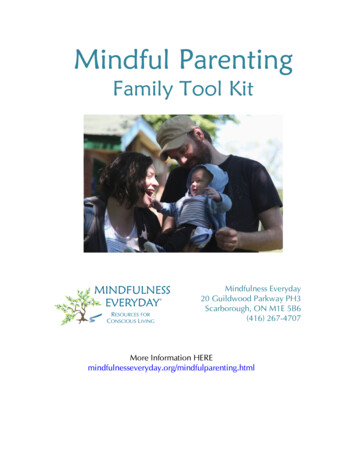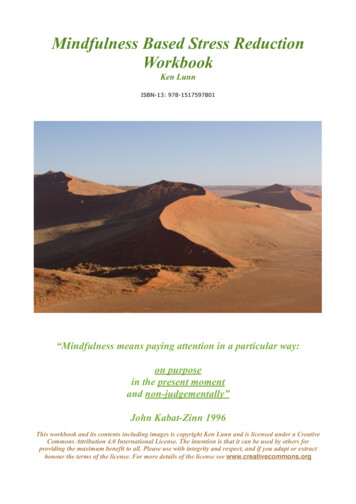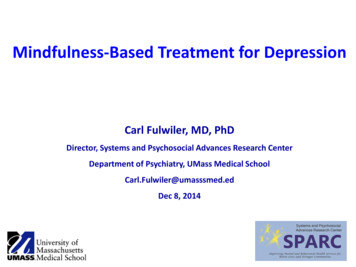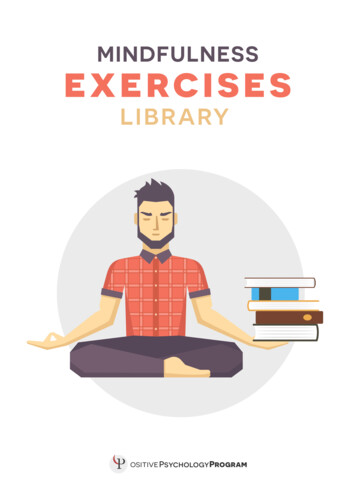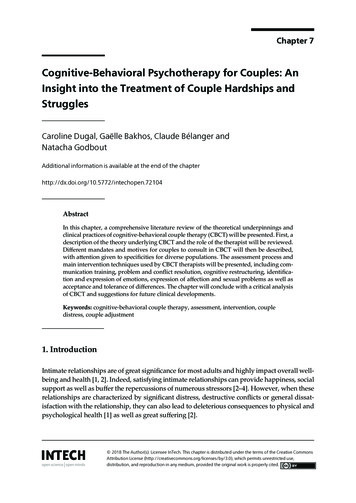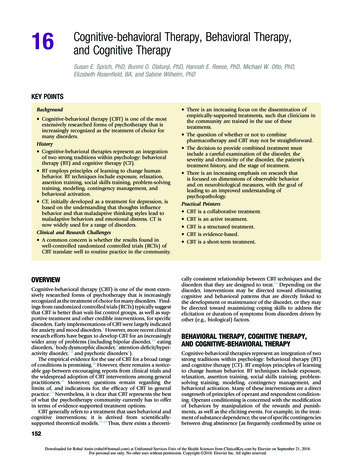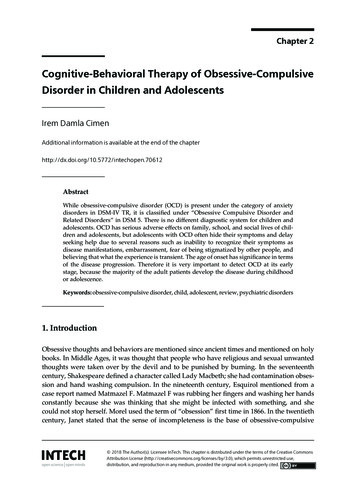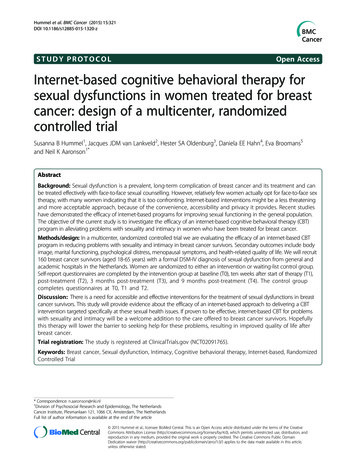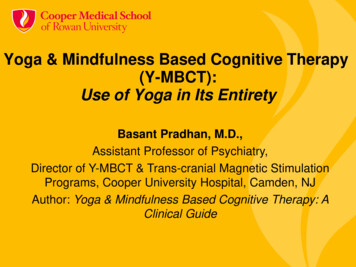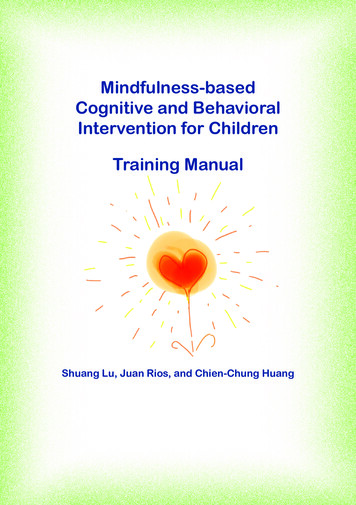
Transcription
Mindfulness-basedCognitive and BehavioralIntervention for ChildrenTraining ManualShuang Lu, Juan Rios, and Chien-Chung Huang
IntroductionMindfulness is bringing attention to this moment in time, withoutjudging the experience. Be aware of and focus on the “here-andnow” – be mindful of what you are doing while you are doing it andfeel what is happening while it is happening. It is a way to find anddevelop inner peace and enjoyment1.Mindfulness is found to affect positive change in behavior, emotion,and social relationship when it is applied to children and teenagers. Itmakes children better concentrate, more confident, kinder to oneselfand others, and less judgmental2. It brings us more patience, trust,and acceptance. It relieves our stress, depress, anxiety, and otherunhealthy emotions. Mindfulness intervention with elementaryschool children in the U.S. is also found to significantly improvechildren’s classroom behaviors, such as paying attention, self-control,participation in activities, and caring and respect for others3.This training manual is developed based on the concept andapproaches of mindfulness. Our purpose is to improve children’scognitive and behavioral outcomes, such as ability to concentrate,self-discipline, emotional regulation, and interpersonal interactionskills. This manual includes eight sessions of an intensive, weeklybased, in-classroom mindfulness intervention. Each of the sessionsinvolves a topic that is closely related to children’s daily life: from themost basic, everyday breathing and eating habit, to acknowledgingand regulating emotions, and to growing rationality, kindness, andopenness to improve interpersonal relationships.ii
We hope the information will help you understand the approaches ofmindfulness, and familiarize you with mindfulness activities that areadapted for elementary-school-age children. We are excited to notonly share our knowledge of mindfulness, but also use this practiceto promote children’s healthy development with you. Please feelfree to contact us with any questions or feedback from your ownmindfulness practice (huamin@ssw.rutgers.edu)!We would like to thank our staff at the Huamin Research Center fortheir genuine effort to develop this training manual – Mengli Chen,Yafan Chen, Kesha Peng, Di Sun, Xin Wen, and Jade Yip. We wouldalso like to thank the Huamin Charity Foundation for its generoussupport of the training program.We would like to thank our staff at the Huamin Research Center fortheir genuine effort to develop this training manual – Mengli Chen,Yafan Chen, Kesha Peng, Di Sun, Xin Wen, and Jade Yip. We wouldalso like to thank the Huamin Charity Foundation for its generoussupport of the training program.Table of ContentsSession 1 Life with Mindfulness1Session 2 Breathing Exercise8Session 3 Mindful Eating15Session 4 Getting to Know Your Emotion19Session 5 Distress Tolerance28Session 6 Rational Decision-Making33Session 7 Gratitude Activity37Session 8 Moving Forward41Sincerely,Shuang Lu, Juan Rios, and Chien-Chung HuangHuamin Research Center, Rutgers University School of Social Work1. Collard, Patrizia. (2014). The little book of mindfulness: 10 minutes a day to less stress,more peace. London, UK: Gaia Books.2. Snel, Eline. (2013). Sitting still like a frog: Mindfulness exercises for kids. Boston, MA:Shambhala Publications.3. Black, David. & Fernando, Randima. (2014). Mindfulness training and classroom behavioramong lower-income and ethnic minority elementary school children. Journal of Child andFamily Studies, 23, 1242-1246.iiiiv
Session 11Session 1: Life with MindfulnessThis first session is one of the most important sessions since it buildsthe energy, expectation and interest of the children involved. Yourpreparedness and ability to show enthusiasm over the next few weeksis critical in building an environment for children to feel comfortableto share and open-minded to learn new skills.Learning GoalsThis session introduces core concepts and goals of mindfulness, suchas what mindfulness is, what are the benefits of verbalizing feelingsand expressions, and what are the purposes of this training (referringto Introduction, page ii). Also, the facilitator will build the rapportwith the children and set the group rules (e.g. being respect to eachother, providing non-judgmental comments, engaging in activities asmuch as possible) during this session.Materialsw Inside-Out movie clipw A/V equipmentw Cut-out images of Inside-Out characters (Appendix 1-A)Activity/ProcedureDuring this session, stage the room with images or pictures thatrepresents different emotions such as happy, sad, and angry. Theimages for this session will be based on the Disney/ Pixar characters“ Inside-Out”. The five characters- Anger, Joy, Sadness, Disgust, andFear will be cut out and placed in different sections of the room forvisual identification.
Life with MindfulnessSession 1Facilitators will begin by introducing themselves and the purposeof the program. The curriculum and goals will be briefly explainedfor full transparency. Next, the facilitators will engage the childrenin explaining the different characters in the room that representsfeelings and relate it to why it is important to have skills to controlour emotions, decisions, and actions.wTake a moment to notice how your body feels as you bringyour attention to the flow of your breath. You don’t need to breathein a special way. Your body knows how to breathe.Next, if time allows, the facilitators have the option of showing abrief clip of the movie, “Inside-Out”, and engage the children intheir observations. Or facilitators can move forward and begin thebreathing exercise (follow instructions below).wIf you notice your mind is caught up in thoughts, concerns,emotions or body sensations, know that this is normal. Notice what isdistracting you and gently let it go without judgment, by redirectingyour attention back to the breath. Keep escorting your attention backto the experience of breathing.2“Time to Breathe”A first step to developing more mindfulness in your daily life islearning new ways to pay attention and connect to experiences inthe moment. One easy way to bring your awareness to the presentmoment is developing a consistent breathing practice. We call thiscore mindfulness practice "time to breathe."To get started, schedule specific times in the day that you can stop,take time to breathe, and observe how that works for you. Ideally,practice breathing mindfully for 3-5 minutes a day.wSit in a comfortable position. Allow both soles of your feetto connect to the floor. Rest your hands on your thighs and let yourshoulders drop. Let your spine grow tall and noble like the trunk of atall tree.wGently close your eyes or look for a reference point somewhereon the floor where you can return your eyes when they get distracted.3wSimply notice each breath coming into the body with an inbreath, and leaving the body with an out-breath.wWhen you are ready, slowly bring your attention back to yoursurroundings and let how you feel now guide you. Gently open youreyes or move your sight from the reference point.
4Life with MindfulnessAfter completion of the exercise, process with the children what theynoticed during their breathing.Potential Challenges & SolutionsChildren may be hyperactive after seeing many photos and movieclips and they cannot calm down to listen to the facilitator. In thiscase, the facilitator can use quiet games in classroom, such as “theQuiet Bubble”:wHave the children say the word “bubble!” together after thefacilitator counts to three.wAsk everyone to mimic as if there is a big bubble in the mouth.wHold “the bubble face” for 20 seconds, until the classroom getsquiet. Now we can release our bubble together.Session 15Take-home MessageThis session introduces the children to developing insight andawareness and how their body influences their emotional states. Themore awareness that is developed, the more conscious they are overtheir actions and can make rational choices with a regulated body.Try this!Instruct the children to practice deep breathing exercises at leasttwice in between sessions. Children can report back their use ofbreathing and when they use it.
6Life with MindfulnessSession 1Appendix 1-AAppendix 1-B7Alternative ActivityDrawing ExerciseMaterialswPen and paperProcedurewPick up an object on your table and draw it.wDraw exactly what you see, not what you think you are seeing.wDo this a couple of days in a row; you will begin to see moreand more of the object, while your drawing becomes more andmore accurate and detailed. By observing without judging, youwill see more of the world around.
Breathing Exercise8Session 2: Breathing ExerciseMany people do not know how to breathe properly or rarely do theyunderstand their relationship with their breath. In fact, a breathingexercise can be an effective tool to increase ability of concentrationand reduce anxiety and stress. Just as athletes learn to adjust theirbreathing when they are running in order to keep their bodies andemotions in good conditions, breathing mindfully can help childrenstabilize their emotions, improve class performance and have longterm benefit to their growths.Learning GoalsSession 29tomorrow. What will you do?”). Introduce the importance ofbreathing and the purpose of breathing exercise.wLet the children sit still and keep quiet. Ask them to place onehand on their heart and another on their belly.wBegin the breathing exercise. Instruct the children step by step.o Imagine you are sitting in a peaceful place (you may seethe sky, cloud, river, mountain, etc.). The facilitator can showthem pictures of scenery, play music if necessary.o Pay attention when you breathe in and out; feel the rises andfalls in your chest and belly; hear your breath; notice thetempo of your breath – you may pause between breaths,sometimes heavy, sometimes light.This session educates children on the importance of breath and itsrelationship with affect regulation and ability of concentration. It alsoreminds children to observe their breath and heartbeat, and learn tomindfully adjust their bodies when they face stress and tension intheir lives.wDiscuss the activity. Ask the children what they think of duringthe exercise and how they feel about this exercise.MaterialsPotential Challenges & SolutionswPictures of beautiful scenery such as countryside view, thenature (see Appendix 2-A for examples).wNature music clips (Example: Wu Chin-tai’s nature musichttps://www.youtube.com/watch?v qcd87wc7HDg)Activity/Procedure4w Discuss with children about what they will do when theyface anxiety or stress (such as “You are worrying about an exam4. Adapted from: Collard, Patrizia. (2014). The little book of mindfulness: 10 minutes a day toless stress, more peace. London, UK: Gaia Books, pp. 30-31.Snel, Eline. (2013). Sitting still like a frog: Mindfulness exercises for kids. Boston, MA:Shambhala Publications, pp. 19-27.Some children may become hyperactive about the activities andcannot calm down to listen to the facilitator. In this case, thefacilitator can play a classroom quiet game, such as “the Quite
Breathing ExerciseSession 2Bubble” (see Session 1, Potential Challenges & Solutions section).Appendix 2- A10If children get bored or cannot pay attention to the breathing exercise,the facilitator can talk to the distracted children in low voice, drawtheir attention back to the activities without disturbing others.Take-home MessageThis session helps children to pay attention to their breaths andbodies. It trains children’s minds to focus on one thing and resistthe interference from the outside. More importantly, by doing theactivity, children will learn how to adjust themselves when they facetransitional events or stressful conditions in life.Try this!Practice this when you are at tense moments: before an exam, conflictwith a friend, etc.11
12Breathing ExerciseSession 213Appendix 2-BAlternative Activity“Take Your Pulse” 5When our heart beats, we can feel it pumping blood. The way andrate at which the heart pumps blood is our pulse. Feeling ourpulse helps us to understand how our body changes along with ouremotions.ProcedurewLet the children sit still and teach them how to feel their pulse.There are two places where we can feel our pulse.o First, we can take our first two fingers and place them on ourwrist on the palm side of our arm. If you put your fingersthere very gently and don’t press down, you may feel as ifsomething is lightly tapping on your fingers. Move yourfingers around a little and sit quietly until you can feel it.o Or you can take your fist two fingers and place them on thefront of your neck below your jaw and above your chest.Gently place them and move them around until you feel thepulse.wTake your pulse. Write down how many pulses you counted in30 seconds.wStand up and jump for 15 seconds.5. 改 编 自:Burdick, Debra. (2014). Mindfulness skills for kids and teens: A workbook forclinicians & clients with 154 tools, techniques, activities & worksheets. Eau Claire, WI: PESIPublishing & Media, pp. 46-47.
Breathing ExerciseSession 3wTake your pulse again – this is how your pulse will be likewhen you are angry, scared, or anxious.Session 3: Mindful Eating14wBreathe in slowly through your nose and gently blow out likeyou are blowing a huge bubble. Repeat it for five times.wNow take your pulse again for 30 second. Write down howmany pulses you counted this time. Feel how the breathing calms youdown.15In this session, we will introduce the concept and approaches ofmindful eating. Mindful eating is a practice that simply pays attentionto what you eat. It focuses on “eating slowly, without distraction”.To educate children to eat mindfully is good for the body to digestand get more nutrition. In this way, children may find that having acommon meal becomes a richer experience6.Learning GoalsThe primary goal for this session is to educate children on therelationship between food and our body and mind. Creatingawareness of this relationship can improve their senses and gratitudeof food. Age 10-12 is a crucial period for children’s growth, whentheir bodies are in great need of energy and nutrition. This exercisewill help children develop healthy eating habit and balance nutritionintake.Materialsw Food (e.g. lunchbox)Activity/Procedure“You Are a Scientist” (May be conducted during school lunch time)wIntroduce the relationship between food and our body andmind, and the concept and effects of mindful eating. Then askchildren to follow the instructions below step by step.6. Burdick, Debra. (2014). Mindfulness skills for kids and teens: A workbook for clinicians &clients with 154 tools, techniques, activities & worksheets. Eau Claire, WI: PESI Publishing &Media, pp. 147-151.
Mindful Eating16Session 317wGently close your eyes; take several relaxing breaths. Imagineobsession with habitual ones7. Also, it helps children to realize thatfood is hard-won and appreciate their meals more.wOpen your eyes. Look at the food and ask yourself: What shapeTry this!wPick up the food slowly and put it in your mouth; but don't biteEncourage children to show their parents this exercise and practicewith them at home.you are a scientist who is about to exam your food for the first time.is it? What size is it? What color is it? What does it smell like?yet. Instead, try to feel the food in your mouth. The facilitator canask children to think about farmers’ hard working in producing theingredients for us. This will help the children learn to appreciate foodmore.w Now take a little bite. Focus on how the food changes inyour mouth. Is it mashing, or softening? When you have chewed itenough, swallow it. Notice how it feels sliding down your throat intoyour stomach.wAfter finishing the meal, close your eyes and take five deepbreaths.Potential Challenges & SolutionsDuring lunch time, some children may get too hungry to do themindful eating exercise. The facilitator can guide them to calm downsuch as lead several minutes breathing exercise.Take-home MessageMindful eating is a powerful practice that offers children manybenefits. Through this activity, children are able to build a healthyrelationship with food, such as reduced fear of new foods or7. The Center for Mindful Eating (n.d.). Introducing mindful eating.Retrieved from http://thecenterformindfuleating.org/
18Mindful EatingSession 4Appendix 3-ASession 4: Getting to Know Your EmotionAlternative Activity“Drink Differently”MaterialswA glass of water for each childProcedurewClose your eyes and take a deep breath.wTake a small sip and feel the water flow into your stomach.wDrink slowly, until finish the water.wTake a deep breath.wThink about:o What does the water look like?o What does it taste like?oHow does this exercise feeldifferently from your normallydrinking habit?19This session focuses on the recognition of emotion. To manageemotion and alleviate stress, children first need to know what isemotion and why they have these feelings. This session encourageschildren to look into their thoughts and feelings and also explore theconnections between them. Thus, children can understand and buildskills to regulate their emotion.Learning GoalsThis session helps children recognize their emotional status and thecauses of emotional changes. It also encourages children to expresstheir feelings. Recognizing, accepting, and expressing both positiveand negative feelings will prepare children to regulate their emotionsand adjust negative feelings – which we will discuss in the nextsession.MaterialswPenwPictures of different emotions (Appendix 4-A)Activity/Procedure“Getting to Know Your Emotions”w Divide children into groups of four. Hand out pictures ofdifferent emotions to the groups. Each participant will get twoexpressions; each group gets eight expressions in total.wHave children name the expression on their own (e.g. “sad”).
Getting to Know Your EmotionSession 4wWrite down a real-life event when they would feel the sameexpression (e.g. “I feel angry when I just had a fight with my friend”).w The facilitator hands out a prepared picture to each child(Appendix 4-B).w Write down their thoughts at that time (e.g. “I am angrybecause my friend didn’t listen to me”).wThe facilitator provides instruction of the diary by showingexamples.oWrite down one thing that happened to you today.oDraw the face of the cartoon character to show how you feelabout this thing.oWrite down the name of that feeling (e.g. happy, proud,anxious, sad, etc.).oWrite down what is going through your mind in the “thoughtbubble”.oDate the diary in the bottom.20wAsk children to share the expression they just named and therelated real-life event within the team when everyone finishes thetask. If time allows, invite some children to share with the wholeclass.Potential Challenges & SolutionsSome children may not recognize the expression or worry aboutbeing “wrong”. The facilitator should encourage children to use theirimagination and be confident. If children do get emotions on theopposite way, the facilitator should ask why they think that way, whatdifference they think between the two emotions (their recognition andreal intention of image), and ask the children to mimic that face andprovide situations when they have that expression with that feelings.21Take-home MessageThis session introduces methods for children to be aware of theiremotion and look into feelings. With a deepened understanding ofemotion, children could better regulate their emotions and thus makewise choice in daily life.Try This!“Catching Feelings and Thoughts Diary”88. Adapted from Friedberg, Robert D., Friedberg, Barbara A., & Friedberg, Rebecca J. (2001).Therapeutic exercises for children: Guided discovery through cognitive behavioral techniques.Sarasota, FL: Professional Resource Exchange, Inc.
Getting to Know Your Emotion22Session 423Appendix 4-A[For facilitator: Respectively, the emotions in this appendix are: sad,anxious, angry, happy, shy, unsatisfied, surprised, and t:Thoughts:
Getting to Know Your ssion :Thoughts:
26Getting to Know Your EmotionSession 4Appendix 4-BAppendix 4-C27Alternative ActivityDate:“Paper Plate Emotion Mask”Event:MaterialsEmotions:Thoughts:wMaker pen and paper plate (cut into half beforehand)ProcedurewHand out every child a half-cut paper plate.wAsk the children to draw a nose and a mouth on the plate toshow a feeling they have had before.wGuide the children to wear the plate as a mask. Combiningwith their own eyes, show their partners the expression they drew.Talk with their partners about the event that gives them the feeling.wAsk some children to share their masks with the whole class,and also the event.
Distress ToleranceSession 5Session 5: Distress ToleranceIn addition to using five senses, the facilitator can also involvebreathing exercise in this session, and remind children the importanceof using their breaths in emotional regulation.28Now that we learned to explore our emotions, how do we deal withthem? When we feel upset, stressful, or distressed, we usually reactautomatically, without thinking about the consequences. It canoften get into the habit of using unhelpful and often self-destructivebehaviors to help cope9. This session helps children to use the rightskills at the right time to manage their negative emotions.Learning GoalsThis session teaches children how to use their five senses (seeing,hearing, smelling, tasting, and touching) to comfort themselves andanchor themselves to the present and to reality during distressedsituations. Children will learn how to use an object as a groundingtool to detach themselves from emotional pain by focusing on theexternal world rather than the internal self. This “healthy detachment”will allow children to gain control over their feelings and managetheir moods10.If time is limited, the facilitator may focus on the sense of smellingin particular. Smelling, among the five senses, triggers emotions andmemories most often. Smells are first processed by the olfactorybulb, which directly connects to brain areas associated with emotionand memory. Other senses (seeing, hearing, or touching), however,do not pass through these brain areas11.9.Carol, Vivyan. (2009). Dealing with stress: An introduction to healthy coping strategies.Retrieved from thDistress.pdf10. White, Amanda. (2014). Smells ring bells: How smells can trigger emotions and memories.Retrieved from es/11. White, Amanda. (2014). Smells ring bells: How smells can trigger emotions and memories.Retrieved from es/29MaterialswOranges, chocolates, apples, or other eatable objects.Activity/Procedure“Look! It’s an Orange!”wIntroduce the learning goals and the rationale of using fivesenses for distress tolerance.
Distress Tolerance30wHand out the material (e.g. an orange) to each child.wHave the children observe their oranges carefully. Pay attentionduring the observation while without any judgment. Do not add yourinterpretations; describe the object as it is.wTry to answer the following questions:o What does it feel like when you touch it?o What does it look like? (Shape, color, size, etc.)o How does it smell?o How does it taste like?o If you squeeze/roll it, does it sound?Potential Challenges & SolutionsSome of the children may eat the orange before the activity begins.To prevent this, the facilitator can set the rules before handing out theoranges, such as “This is a special orange for you only. You will needit for the whole time during our activity.”Take-home MessageNo feelings need to be suppressed, changed, or expressedimmediately. It is great to feel and to pay attention to them. Bewareof, admit, and acknowledge your feelings.When you’re anxious/worrying/sad, the most important thing is tofirst notice that you’re anxious/worrying. You can try to take severaldeep breaths. While breathing, focus on the rises and falls in yourchest and belly, instead of your mind. This will help you move yourthoughts out of your head and take them to your abdomen, whereSession 531there are no thoughts.It is important to note that distress tolerance skills (such as use agrounding tool) works better when you practice as often as possible.You may try grounding for a long time (10-20 minutes), and repeat.Or create your own methods of distress tolerance that works the bestfor you.Try this!Whenever you feel stressful or anxious, think about our orange andour exercise. Use one of the five senses to do something to manageyour distress: watch a movie (seeing), listen to your favorite music(hearing), smell the flowers (smelling), try a new flavor of ice cream(tasting), or pet your stuffed animal or pets (touching).
32Distress ToleranceSession 6Appendix 5-ASession 6: Rational Decision-Making33MaterialsThis session introduces the definitions of reasonable, emotional, andwise mind. This session also uses daily-life scenario to help childrenthink of pros and cons of their behaviors, help them increase theawareness and ability of self-control and achieve rational decisionmaking.wPen and paperLearning GoalsProcedureThis session aims to help children distinguish between reasonableand emotional mind, and familiarize them with the concept of wisemind. Through comparing the behaviors’ “pros and cons” in differentscenarios, the activity develops children’s rational thinking and selfcontrol ability. This session also helps children to be mindful of theimpacts of their daily-life behaviors.Alternative Activity“Paper Plate Emotion Mask”wDraw an image of weatherreport that reflects your currentfeeling (sunshine, cloudy, rainy,thunderstorm )wAccept this “weather” inside you as it is. You don’t have tochange it – just like you cannot change the outside weather. It is goodto accept all our emotions.wAt the end of the day (or after the activity), check if yourpersonal weather changed. If so, think about what might have causedthe change.wWhat mood are your parents/siblings/friends in today? What’sthe weather report like for them? Observe in a nonjudgmental way.Describe their behavior/emotion as they show up.12.Adapted from Snel, Eline. (2013). Sitting still like a frog: Mindfulness exercises for kids.Boston, MA: Shambhala Publications, pp. 54-56.MaterialswCards with the word “Emotional Mind”, “Reasonable Mind”,and “Wise Mind”wPen and paperActivity/Procedure“Pros & Cons”w The facilitator shows the cards written Reasonable mind,Emotional mind, and Wise mind. Introduce the definition of eachword. Give examples of what these three minds are and clarify thedifferences among them.w Hand out a pen and paper to each child. The facilitator
34Rational Decision-Makingdescribes the following behaviors in daily-life scenarios:o Relationship with parents:PWhen your parents criticize you for being home too late,you argue with your parents.Your behavior in this scenario: Argue with parentso Relationship with peers:PWhen your two friends are fighting with each other, youhelp them to reconcile.Your behavior in this scenario: Help fighting friends toreconcileo School behavior:PYou call a classmate with a derisive nickname, which he/she doesn’t like.Your behavior in this scenario: Call someone a derisivenicknamePWhen you see some of your classmates isolate someone,you gave your hand to support him/her.Your behavior in this scenario: Support an isolatedclassmateSession 635wAfter describing each scenario, have the children write downtheir answers to the following questions:oWhat are the pros and cons of this behavior?oWhat would people with reasonable mind and emotionalmind do under such situation?oWhat do you think is a wise choice in this scenario?wEncourage children to share their answers with the class.wThink about:oWhat did you learn from these daily-life scenario analyses?oHave you ever had similar experience like above-mentionedexamples? What is it?oHow do the skills you learned in former sessions help youuse your wise mind?Potential Challenges & SolutionsChildren may not want to share their experiences at first. Thefacilitator can give an example of his/her own experience first as ademonstration.Take-home MessageThis session helps children to use wise mind to make decisions bycomparing the “Pros and Cons” of their behavior. Thus help childrendevelop ability of self-control and rational behaviorTry this!Whenever you meet such situation, take deep breath and countdown 10 seconds, during which analyzing the pros and cons of yourbehavior.
36Rational Decision-MakingSession 7Appendix 6-ASession 7: Gratitude Activity37wPen and paperGratitude exists everywhere, but we are not aware of it sometimes.With gratitude, we can establish friendly relationships with othersand acknowledge the goodness and happiness in our lives. In thissession, you will lead the children to learn to find the kindnessaround them and understand gratitude. In the sharing part, you canencourage more children to engage in the activity and share theirfeelings during this activity.ProcedureLearning GoalsInstead of the scenarios, ask children to use their own daily-lifeexperiences. Write down the pros and cons of their behaviors inthose events and discuss with their classmates.This session helps children discoverothers’ kindness and learn the reciprocityof gratitude. It develops children’spositive thinking and acceptance ininterpersonal relationships. Utilizingthis ability in daily life will helpchildren establish mutually-supportiverelationships with friends, family, andothers. In addition, being a r
Table of Contents iii iv 1. Collard, Patrizia. (2014). The little book of mindfulness: 10 minutes

